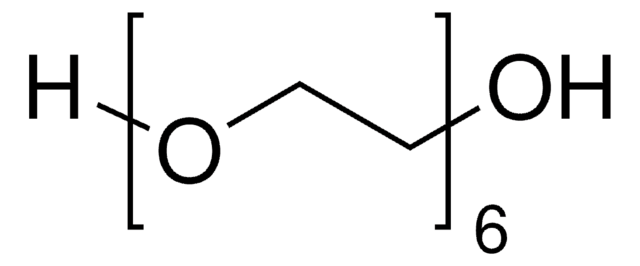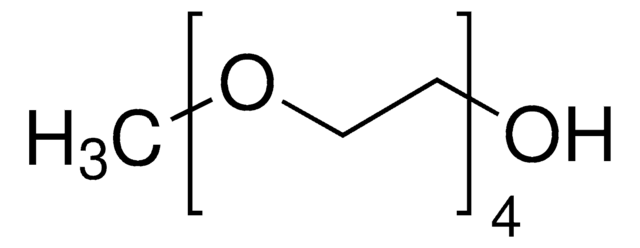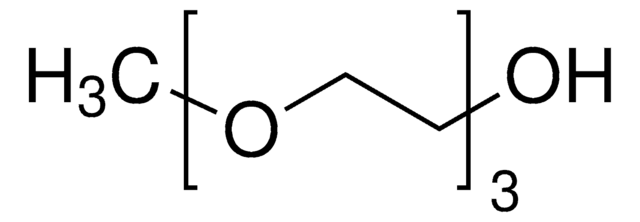335754
Pentaethylene glycol
98%, average MN 250
Synonyme(s) :
Polyethylene glycol, 3,6,9,12-Tetraoxatetradecane-1,14-diol, Pentaglycol
About This Item
Produits recommandés
Nom du produit
Pentaethylene glycol, 98%
Niveau de qualité
Essai
98%
Forme
liquid
Poids mol.
average Mn 250
Indice de réfraction
n20/D 1.462 (lit.)
pb
184 °C/2 mmHg (lit.)
Densité
1.126 g/mL at 25 °C (lit.)
Extrémité Ω
hydroxyl
Extrémité α
hydroxyl
Chaîne SMILES
OCCOCCOCCOCCOCCO
InChI
1S/C10H22O6/c11-1-3-13-5-7-15-9-10-16-8-6-14-4-2-12/h11-12H,1-10H2
Clé InChI
JLFNLZLINWHATN-UHFFFAOYSA-N
Vous recherchez des produits similaires ? Visite Guide de comparaison des produits
Catégories apparentées
Application
- Application of Prussian Blue in Electrochemical and Optical Sensing of Free Chlorine.: This study discusses the use of Prussian Blue on fluorine-doped tin oxide coated glass slides for electrochemical and optical sensing applications, specifically targeting free chlorine detection, highlighting its high sensitivity and stability (Valiūnienė et al., 2022).
- Evaluation of a photoelectrochemical platform based on strontium titanate, sulfur doped carbon nitride and palladium nanoparticles for detection of SARS-CoV-2 spike glycoprotein S1.: The article evaluates the integration of fluorine-doped tin oxide in a complex photoelectrochemical cell designed for the detection of COVID-19′s spike protein, underscoring its potential in rapid diagnostic applications (Botelho et al., 2022).
- Immunodiagnostic of leprosy exploiting a photoelectrochemical platform based on a recombinant peptide mimetic of a Mycobacterium leprae antigen.: This research highlights a novel use of fluorine-doped tin oxide slides in a photoelectrochemical setup for the sensitive and specific immunodiagnosis of leprosy, showcasing the material′s application in medical diagnostics (Yotsumoto Neto et al., 2019).
- Fast and reliable BIA/amperometric quantification of acetylcysteine using a nanostructured double hydroxide sensor.: This paper presents a method utilizing fluorine-doped tin oxide for the rapid and reliable electrochemical detection of acetylcysteine, demonstrating the coating′s effectiveness in enhancing electron transfer and sensitivity in biosensing applications (Correa et al., 2018).
- Nanostructured TiO2 Films Attached CdSe QDs Toward Enhanced Photoelectrochemical Performance.: Discusses the role of fluorine-doped tin oxide substrates in improving the photoelectrochemical properties of TiO2 films combined with quantum dots, which could advance the development of more efficient solar cells and sensors (Du et al., 2016).
Code de la classe de stockage
10 - Combustible liquids
Classe de danger pour l'eau (WGK)
WGK 3
Point d'éclair (°F)
235.4 °F - closed cup
Point d'éclair (°C)
113 °C - closed cup
Équipement de protection individuelle
Eyeshields, Gloves, type ABEK (EN14387) respirator filter
Faites votre choix parmi les versions les plus récentes :
Déjà en possession de ce produit ?
Retrouvez la documentation relative aux produits que vous avez récemment achetés dans la Bibliothèque de documents.
Les clients ont également consulté
Articles
Progress in biotechnology fields such as tissue engineering and drug delivery is accompanied by an increasing demand for diverse functional biomaterials. One class of biomaterials that has been the subject of intense research interest is hydrogels, because they closely mimic the natural environment of cells, both chemically and physically and therefore can be used as support to grow cells. This article specifically discusses poly(ethylene glycol) (PEG) hydrogels, which are good for biological applications because they do not generally elicit an immune response. PEGs offer a readily available, easy to modify polymer for widespread use in hydrogel fabrication, including 2D and 3D scaffold for tissue culture. The degradable linkages also enable a variety of applications for release of therapeutic agents.
Devising biomaterial scaffolds that are capable of recapitulating critical aspects of the complex extracellular nature of living tissues in a threedimensional (3D) fashion is a challenging requirement in the field of tissue engineering and regenerative medicine.
Notre équipe de scientifiques dispose d'une expérience dans tous les secteurs de la recherche, notamment en sciences de la vie, science des matériaux, synthèse chimique, chromatographie, analyse et dans de nombreux autres domaines..
Contacter notre Service technique












